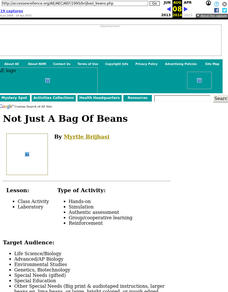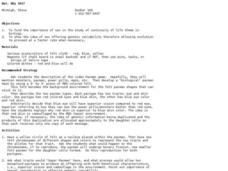Curated OER
Evolution and Gene Frequencies: A Game of Survival and Reproductife Success
Young scholars research the population of Bengal tigers and their existence as either dominant or recessive. They explore the presence of fur on these tigers and its lethal combinations. Determinating the effect of random mating in a...
Curated OER
Flower Population
In this flower population worksheet, high schoolers use a diagram of first and second generations of a flower population to complete 2 short answer questions about genotype and allelic frequency.
Curated OER
Genetics Worksheet
In this genetics worksheet, learners answer a variety of questions about genotypes, phenotypes, genetic inheritance, and traits. They solve for the probability of genotypes and phenotypes of offspring by completing monohybrid and...
Curated OER
Human Genetic Disorder Probabilities
In this genetic disorders worksheet, students complete punnett squares for six different human genetic disorders. They predict the outcome of the offspring including the phenotypes and genotypes of each.
Curated OER
When Heredity Follows Different Rules
In this heredity learning exercise, students will create 3 Punnett squares to determine the genotype and phenotype of the offspring from specific breedings. Then students will answer 7 true or false questions based on chromosomes and...
Curated OER
More Zork Genetics
In this genetics activity, students complete 3 dihybrid crosses of traits to determine the probability of the genotypes and phenotypes of the offspring of the imaginary species, the Zork.
Curated OER
Applying the Laws of Inheritance
Biology and mathematics can be integrated through a study of Mendelian Genetics.
Curated OER
Not Just a Bag of Beans
Learners determine the types of natural selection and variation that exists in a population, using beans.
Curated OER
The Genetics of Parenthood
High schoolers draws the child's face and compares "mother's" and "father's" perception of characteristics. One student draws the child's face; partner writes a biography of the child at age 30- what is the child like, what have they...
Curated OER
Camouflage and Protective Coloration: A Model of Natural Selection
Students study protective coloration and camouflage in animals. They create examples of each and conduct simulation-type experiments to determine which is the most effective adaptation.
Curated OER
How Does Chance Influence Inheritance?
Students complete a lab based on how chance affects which genes appear in gametes as in Mendel's Law of Segregation. They review the theories, vocabulary words, and historical background of Gregor Mendel's work with pea plants. They...
Curated OER
Mutations and Genetic Change
In this genetic mutations worksheet, students compare and contrast different types of mutations including point mutations, silent mutations, and frameshift mutations. This worksheet has 5 matching, 4 fill in the blank, and 3 short answer...
Curated OER
Oompah Loompa Genetics
In this genetics worksheet, students use descriptive information about the different types of Oompa Loompas to show genotype and phenotype plus dominant and recessive traits. This worksheet has 12 problems to solve.
Curated OER
Dihybrid Cross Punnett Squares
In this dihybrid cross instructional activity, students complete two punnett squares for the cross of two traits. They determine the genotypes, phenotypes and phenotypic ratios of the offspring.
Curated OER
Principles of Heredity
Students model traits on genes using colored paper and tongue depressors to represent chromosomes. In this heredity lesson plan, students use their "chromosome sticks" to understand chromosome pairs, genes, dominant traits, recessive...
Curated OER
But, Why Sex?
Students investigate the importance of sexual reproduction in evolution. In this sexual reproduction lesson plan, students simulate species with two traits: eye and skin color. They determine what characteristics are beneficial for the...
Curated OER
Happy Face Spider Propagation
Students research genetic adaptations. In this chromosome lesson, students investigate dominant and recessive genes using spiders indigenous to Hawaii. Students create Punnett squares to determine the probability of passing specific...
Curated OER
Genetics Crossword
In this biology worksheet, students complete a crossword puzzle with 38 questions on genetics. They identify the different parts and functions of a flower.
Curated OER
Heredity Worksheet: Blood Type
In this genetics learning exercise, students use Punnett squares to determine the possible genotypes of offspring based on blood type. This learning exercise has 6 problems to solve.
Curated OER
Dragon Genetics-Independent Assortment and Genetic Linkage
Students build chromosome models using popsicle sticks. In this biology lesson, students simulate the Law of Independent Assortment. They use Punnett squares to predict the resulting genotype and phenotype.
Curated OER
Dragon Genetics Lab-Principles of Mendelian Genetics
Young scholars study genetic traits using popsicle sticks as chromosomes. In this biology activity, students explain how traits are inherited from parents. They differentiate dominant and recessive genes.
Curated OER
Using Blood Tests to Identify Babies and Criminals
Students solve a crime by matching a suspect's blood type to physical evidence collected at the crime scene. In this forensic science lesson, students identify the different blood types. They explain how blood tests work.
Curated OER
EMS Lesson 2: Outrageous Offspring
Students investigate the principles of probability that can be used to predict hereditary traits.
Curated OER
Hardy-Weinberg Equilibrium According to Hoyle:
Students gain a feeling for the significance of the Hardy-Weinberg Equilibrium without using algebra but participating in an interactice game.
Other popular searches
- Multiple Alleles
- Genetics Multiple Alleles
- Co Dominant Alleles
- Codominant Alleles
- Genes Alleles
- Genes and Alleles
- Teaching Multiple Alleles
- Allele Frequencies
- Lethal Alleles
- Trait Gene Allele
- Multiple Alleles Blood Type
- Identifying Alleles

























